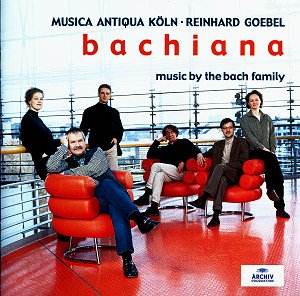It is now 15 years since Archiv brought us Musica Antiqua
Kölnís disc of vocal music by the family precursors of J S Bach.
It is perhaps somewhat surprising that a companion disc of instrumental
music should have taken quite so long to produce, but the material available
is considerably more limited, both in quantity and in quality, than
the vocal music. Although the Bachs were active throughout Thuringia
from the early 17th century at least, the ravages of time have not been
kind to the sources of their instrumental outpourings. J S B himself
kept a family album of music; what his son C P E called an "archive
of the Old Bachs" and several of the works recorded here are from
that. Others are more recent Ďdiscoveriesí, although there is always
the need for a good deal of caution in considering the authenticity
of works which survive only in 19th century copies, and even more required
with reconstructions like that of the last track of this disc. It is
all interesting stuff, and Reinhard Goebel produces good justification
in the accompanying booklet for the various musicological and interpretative
stances he has taken.
Of the music itself, it is clear that the only figure
here who is of really significant note is the one whose works J S B
himself copied, namely Johann Ludwig Bach. Clearly showing the influence
of Italian string music, as well as of the Austrian lineage of figures
such as Schmelzer and Muffat of the previous generation, the Concerto
in D and the Overture in G are fine works, and are given typically Musica
Antiqua Köln vigorous readings. The dance movements of the suite
vary between spiky light articulation in the Gavotte and the Bourée,
and a limpid wistful violin sound in the Airs. Heinrich Bach's two sonatas
"a cinque" are single movement pieces with several contrasting
sections, but they were probably sounding old-fashioned when they were
written. This is very much the Schmelzer style, but Schmelzer just did
this sort of thing better. The works arenít helped by a few passages
of rather thin sounding string playing.
The extensive set of variations by Johann Christoph
Bach show an interesting precursor of J S Bís own harpsichord variations.
The material is nothing special, but the range of devices used in the
variations is considerable, and Léon Berben performs them with
admirable clarity. Personally, this writer finds the harpsichord sound
rather characterless. The maker and style of the instrument are not
mentioned, but it could have done with something brighter in the top
register and gutsier in the bass. The two works that look at first glance
to be in the wrong disc are, in fact, merely more distant relations.
Signr Pagh is believed to be the brother of Johann Christoph of the
harpsichord variations mentioned above, and his Sonata and Capriccio
again show the influence of Muffat and Schmelzer, even of Biber in the
solo violin writing. This is a pleasant work in the old style and is
played with panache. Cyriacus Wilche is thought to have been Anna Magdelena
Bachís grandfather (she was born a Wilcke - like the Bachs, they had
several spellings) and therefore the great-grandfather of Johann Christian
(the London) Bach. Regrettably, was limited in his talent, "Battaglia"
being a pretty dull work. The disc would not have missed its seven minutes
at all.
The highpoint is, of course, the J S B at the end.
The wonderful two movement Sinfonia from the Easter Oratorio has been
here turned into a concerto by re-orchestrating the opening chorus of
the Oratorio for instruments only. There is absolutely no evidence that
this is a Ďlostí movement, but the outcome is quite effective and the
trumpets and drums make a splendid silvery contribution to offset rather
a lot of string writing elsewhere.
Peter Wells


